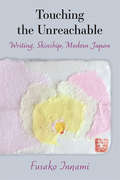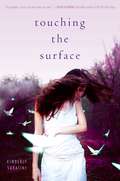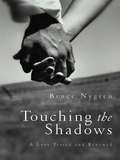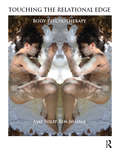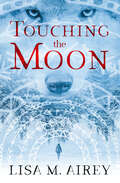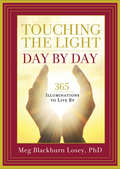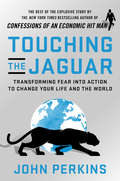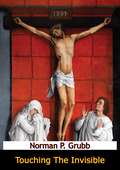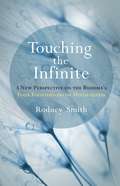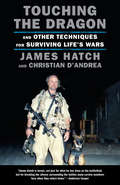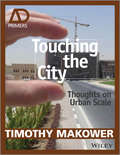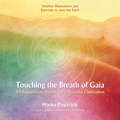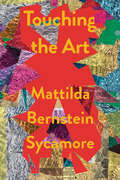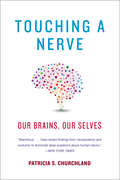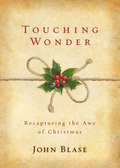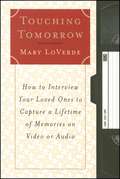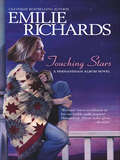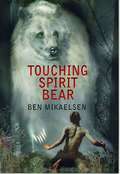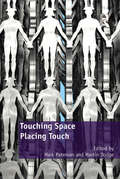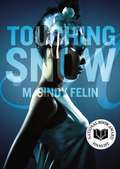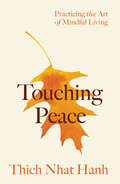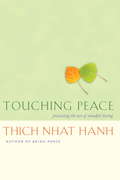- Table View
- List View
Touching the Unreachable: Writing, Skinship, Modern Japan (Michigan Monograph Series in Japanese Studies #91)
by Fusako InnamiFusako Innami offers the first comprehensive study of touch and skinship—relationality with the other through the skin—in modern Japanese writing. The concept of the unreachable—that is, the lack of characters’ complete ability to touch what they try to reach for—provides a critical intervention on the issue of intimacy. Touch has been philosophically addressed in France, but literature is an effective—or possibly the most productive—venue for exploring touch in Japan, as literary texts depict what the characters may be concerned with but may not necessarily say out loud. Such a moment of capturing the gap between the felt and the said—the interaction between the body and language—can be effectively analyzed by paying attention to layers of verbalization, or indeed translation, by characters’ utterances, authors’ depictions, and readers’ interpretations. Each of the writers discussed in this book—starting with Nobel prize winner Kawabata Yasunari, Tanizaki Jun’ichiro, Yoshiyuki Junnosuke, and Matsuura Rieko—presents a particular obsession with objects or relationality to the other constructed via the desire for touch. In Touching the Unreachable, phenomenological and psychoanalytical approaches are cross-culturally interrogated in engaging with literary touch to constantly challenge what may seem like the limit of transferability regarding concepts, words, and practices. The book thereby not only bridges cultural gaps beyond geographic and linguistic constraints, but also aims to decentralize a Eurocentric hegemony in its production and use of theories and brings Japanese cultural and literary analyses into further productive and stimulating intellectual dialogues. Through close readings of the authors’ treatment of touch, Innami develops a theoretical framework with which to examine intersensorial bodies interacting with objects and the environment through touch.
Touching the Surface
by Kimberly SabatiniExperience the afterlife in this lyrical, paranormal debut novel that will send your heart soaring.When Elliot finds herself dead for the third time, she knows she must have messed up, big-time. She doesn't remember how she landed in the afterlife again, but she knows this is her last chance to get things right. Elliot just wants to move on, but first she will be forced to face her past and delve into the painful memories she'd rather keep buried. Memories of people she's hurt, people she's betrayed...and people she's killed. As she pieces together the secrets and mistakes of her past, Elliot must find a way to earn the forgiveness of the person she's hurt most, and reveal the truth about herself to the two boys she loves...even if it means losing them both forever.
Touching the Surface
by Kimberly SabatiniExperience the afterlife in this lyrical, paranormal debut novel that will send your heart soaring.When Elliot finds herself dead for the third time, she knows she must have messed up, big-time. She doesn't remember how she landed in the afterlife again, but she knows this is her last chance to get things right. Elliot just wants to move on, but first she will be forced to face her past and delve into the painful memories she'd rather keep buried. Memories of people she's hurt, people she's betrayed...and people she's killed. As she pieces together the secrets and mistakes of her past, Elliot must find a way to earn the forgiveness of the person she's hurt most and reveal the truth about herself to the two boys she loves...even if it means losing them both forever.
Touching the Shadows
by Bruce NygrenMany issues can strain a marriage relationship, but none is as challenging as a life-threatening illness. Every year, almost two hundred thousand women are diagnosed with breast cancer. When Racinda Nygren joined the ranks of these women, she and her husband, Bruce, were thrust into an agonizing season of their marriage. With warmth and depth, Bruce shares their moving story. Touching the Shadows shows the power of love and faith amid a harrowing trial and will encourage readers to renew their own commitment to their spouse and celebrate God's special gift of love together.
Touching the Relational Edge: Body Psychotherapy
by Asaf Rolef Ben-ShaharThis book introduces body psychotherapy to psychologists, psychotherapists, and interested others through an attachment based, object relations, and primarily psychoanalytic and relational framework. It approaches body psychotherapy through historical, theoretical and clinical perspectives.
Touching the Moon (Touching the Moon)
by Lisa M. AireyEscaping her abusive past, a woman settles in a small town and finds herself pursued by two men—and protected by a mysterious wolf. A veterinarian by training and a gifted healer by nature, Julie Hastings escapes to rural South Dakota, hoping to escape past traumas and start over. What she finds instead are two men who suddenly rival for her attention: one the overprotective chief of police, the other a powerful member of the Sioux Indian nation. Each man longs to help Julie find the peace she desperately needs—a serenity that is shattered when a brutal murder rocks the neighborhood. Trusting people is not in Julie&’s nature, so when a mysterious wolf befriends her, she leans into his protective animal instincts. Until the shocking truth about her beastly protector shakes her to the core, shattering everything she once understood about love.
Touching the Light, Day by Day: 365 Illuminations to Live By
by Meg Blackburn LoseyEmbark on a year-long journey of spiritual and personal growth with daily affirmations to guide you every step of the way. Meg Losey is a spiritual teacher with her feet planted firmly on the ground. Her teachings help readers &“get real,&” claim their own power, and use it for the good of their mind, body, and spirit of others. Touching the Light Day by Day offers 365 quotes and brief healing and inspiring meditations. It&’s a great book for either beginning or deepening a practice. It&’s invaluable for both the novice and the expert to get in touch with their own inner voices and spirit guides. Losey invites us to open our hearts and merge with God Consciousness, something, as she teaches, anyone can do. This little gem of a book is Meg Losey&’s gift to her readers. These illuminations come to her each morning. She invites readers to use them as they will—for daily meditation. Or open at random to find a helpful thought. Or use them to invite your own spirit guides into your lives.
Touching the Jaguar: Transforming Fear into Action to Change Your Life and the World
by John Perkins"This eloquent book inspires us to create a new reality of what it means to be humans on this magnificent planet."—Deepak ChopraThis all happened while Perkins was a Peace Corps volunteer. Then he became an "economic hit man" (EHM), convincing developing countries to build huge projects that put them perpetually in debt to the World Bank and other US-controlled institutions. Although he'd learned in business school that this was the best model for economic development, he came to understand it as a new form of colonialism. When he later returned to the Amazon, he saw the destructive impact of his work. But a much more profound experience emerged: Perkins was inspired by a previously uncontacted Amazon tribe that "touched its jaguar" by uniting with age-old enemies to defend its territory against invading oil and mining companies. For the first time, Perkins details how shamanism converted him from an EHM to a crusader for transforming a failing Death Economy (exploiting resources that are declining at accelerating rates) into a Life Economy (cleaning up pollution, recycling, and developing green technologies). He discusses the power our perceptions have for molding reality. And he provides a strategy for each of us to change our lives and defend our territory—the earth—against current destructive policies and systems.
Touching the Invisible
by Norman P. GrubbHow can I have Christ's power in my everyday life?Until we know how to recognize God's voice, we are unsure of His will, uncertain in our prayers, and ineffective in our Christian service. Norman Grubb opens the reality of living secretly with God, whose invisible resources become more real than the visible world around us. The answers here have revolutionized the lives of thousands, providing practical help for those who desire a life of power; the heritage of all who are "hidden with Christ in God."
Touching the Infinite: A New Perspective on the Buddha's Four Foundations of Mindfulness
by Rodney SmithA prominent Insight Meditation teacher explores the profound implications of the traditional Buddhist teaching on the four areas to which mindfulness is applied as a means to liberation.Awakening manifests through the application of mindfulness to four areas: body, feelings, mind, and dharmas. Buddhists of all the traditions share this principle found in the Satipatthana Sutta, which has been expounded upon since the time of the Buddha himself. Rodney Smith challenges us to hold this teaching up against our own experience, and in doing so to discover the inherent interconnection of all Four Foundations. They are revealed to be a sequential path leading the practitioner from the world of form to the joyous perception of the formless. The Four Foundations of Mindfulness thus serve as a road map for any genuine spiritual path.
Touching the Earth: Guided Meditations for Mindfulness Practice
by Thich Nhat HanhThough the original edition of Touching the Earth is deeply embraced by those already practicing mindfulness in the tradition of Thich Nhat Hanh, the revised edition seeks to make the exercises contained within more accessible for those new to Buddhist or mindfulness practice. <P> <P> Based on the loving kindness and compassion meditation of the Lotus Sutra, Touching the Earth contains one of the most popular and transformative practices of Thich Nhat Hanh. Written as a poetic conversation with the Buddha, it is a step-by-step guidebook to the practice of 'Beginning Anew'. Thich Nhat Hanh describes it as having the capacity to removing obstacles brought about by past wrongdoings and to bring back the joy of being alive. According to many of his students who are deeply touched by this practice, it can help renew our faith and develop our compassion. It presents a opportunity to heal our relationships through forgiveness and to embrace our ancestors, parents, teachers, and ourselves. Touching the Earth contains clear instructions for the 'Beginning Anew' practice with over 40 guided meditation verses, allowing the reader to practice alone or with others.
Touching the Dragon: And Other Techniques for Surviving Life's Wars
by James Hatch Christian D'AndreaFrom former special ops Navy SEAL senior chief; master naval parachutist (four Bronze Stars with Valor, Navy and Marine Corps Medal recipient, etc.); fighter in 150 missions (Iraq, Afghanistan, Bosnia, Africa); expert military dog trainer and handler whose SEAL dogs were partners and medal winners--a fierce, moving tale of a return from hell, being badly wounded on a special ops mission that ended his two-decades-long military career, his searing recovery, and the struggle to live life off the speeding train of war.In Touching the Dragon, James Hatch, Naval Special Warfare Operator, expert commando, tactical master in deadly operations, twenty-four years in service to his country (he enlisted in the Army National Guard at age seventeen), writes of his years of military service, from joining the Navy at eighteen, becoming a SEAL, to his joining the Naval Special Warfare Development group ("If I died in a gunfight, it would be doing something I loved"). He writes of the harrowing secret missions (Iraq, Bosnia, Africa); and of the fateful final mission (Afghanistan), that left him badly shot (a bullet exploding through his femur and out the back of his leg) as Hatch and his SEAL team crew were attempting to rescue a rogue soldier--Pvt. Bowe Bergdahl, who deserted his post, was captured by Al Qaida and Taliban militants, and was set to be smuggled to a part of the world where Americans could never reach him. Hatch writes of the horrific wound to his leg; of having no choice but to end his military career; of coming home to the country he'd spent his life defending; of the ordeal of getting well physically (eighteen surgeries; twelve months of recovery; learning to walk again); of having to find out who he was as a man apart from the chaotic world of special operations missions; of days and months of despair, alcoholism, the pull toward suicide; and of finally, through love of family, friends, soldiers, and his specially trained military dogs, touching the dragon, of going through the fear of feeling unfit for society, of finding a purpose and a way back to life.
Touching the City: Thoughts on Urban Scale (Architectural Design Primer)
by Timothy MakowerScale in cities is relative and absolute. It has the ability to make us feel at home in the world or alien from it; connected or disconnected. Both large and small scale in cities can be beautiful; both are right, neither is wrong. Whilst accepting that prescription is no answer, 'getting the scale right' – at an intuitive and sensual level – is a fundamental part of the magic of architecture and urban design. Touching the City explores how scale is manifested in cities, exploring scale in buildings, in the space between them and in their details. It asks how scale makes a difference. Travelling from Detroit to Chandigarh, via New York, London, Paris, Rome and Doha, Tim Makower explores cities with the analytical eye of a designer and with the experiential eye of the urban dweller. Looking at historic cities, he asks what is good about them: what can we learn from the old to inform the new? The book zooms in from the macro scale of surfing Google Earth to micro moments such as finding fossils in a weathered wall. It examines the dynamics and movement patterns of cities, the making of streets and skylines, the formation of thresholds and facades, and it also touches on the process of design and the importance of drawing. As the book's title, Touching the City, suggests, it also emphasises the tactile – that the city is indeed something physical, something we can touch and be touched by, alive and ever changing.
Touching the Breath of Gaia
by Marko PogacnikArguing that what the earth chiefly needs is conscious human cooperation beyond the material realm, this unique, interactive, spiritual perspective on how to save the planet describes ways to communicate with Gaia herself and become her hands, allowing her to use her vast resources to save all the creatures on her surface, including humans. Because people have forgotten how to listen and converse with the goddess, this book purports that she uses natural catastrophes as her "hands," to get humankind's attention. By using the exercises for personal growth, readers can learn to use their emotions, intuition, and feelings rather than intellect and these traumas will be avoided and replaced with joy and companionship.
Touching the Art
by Mattilda Bernstein SycamoreA daringly observant memoir about intergenerational trauma, fine art, and compartmentalization from a returning Soft Skull author and Lambda Literary Award winnerA mixture of memoir, biography, criticism, and social history, Touching the Art is queer icon and activist Mattilda Bernstein Sycamore&’s interrogation of the possibilities of artistic striving, the limits of the middle-class mindset, the legacy of familial abandonment, and what art can and cannot do.Taking the form of a self-directed research project, Sycamore recounts the legacy of her fraught relationship with her late grandmother, an abstract artist from Baltimore who encouraged Mattilda as a young artist, then disparaged Mattilda&’s work as &“vulgar&” and a &“waste of talent&” once it became unapologetically queer.As she sorts through her grandmother Gladys&’s paintings and handmade paperworks, Sycamore examines the creative impulse itself. In fragments evoking the movements of memory, she searches for Gladys&’s place within the trajectories of midcentury modernism and Abstract Expressionism, Jewish assimilation and white flight, intergenerational trauma and class striving.Sycamore writes, &“Art is never just art, it is a history of feeling, a gap between sensations, a safety valve, an escape hatch, a sudden shift in the body, a clipboard full of flowers, a welcome mat flipped over and back, over and back, welcome.&”Refusing easy answers in search of an embodied truth, Sycamore upends propriety to touch the art and feel everything that comes through.
Touching a Nerve: Our Brains, Our Selves
by Patricia S. ChurchlandA trailblazing philosopher's exploration of the latest brain science--and its ethical and practical implications. What happens when we accept that everything we feel and think stems not from an immaterial spirit but from electrical and chemical activity in our brains? In this thought-provoking narrative--drawn from professional expertise as well as personal life experiences--trailblazing neurophilosopher Patricia S. Churchland grounds the philosophy of mind in the essential ingredients of biology. She reflects with humor on how she came to harmonize science and philosophy, the mind and the brain, abstract ideals and daily life. Offering lucid explanations of the neural workings that underlie identity, she reveals how the latest research into consciousness, memory, and free will can help us reexamine enduring philosophical, ethical, and spiritual questions: What shapes our personalities? How do we account for near-death experiences? How do we make decisions? And why do we feel empathy for others? Recent scientific discoveries also provide insights into a fascinating range of real-world dilemmas--for example, whether an adolescent can be held responsible for his actions and whether a patient in a coma can be considered a self. Churchland appreciates that the brain-based understanding of the mind can unnerve even our greatest thinkers. At a conference she attended, a prominent philosopher cried out, "I hate the brain; I hate the brain!" But as Churchland shows, he need not feel this way. Accepting that our brains are the basis of who we are liberates us from the shackles of superstition. It allows us to take ourselves seriously as a product of evolved mechanisms, past experiences, and social influences. And it gives us hope that we can fix some grievous conditions, and when we cannot, we can at least understand them with compassion.
Touching Wonder
by John BlaseThis bold retelling of Luke 1-2, based on Eugene Peterson's Message translation, reads like a novel and invites readers to experience the Nativity with fresh wonder.To Eugene Peterson's The Message Bible translation, John Blase adds his own storytelling voice, exploring the familiar events from multiple first-person viewpoints. What emerges is the intimate story of unlikely people--a frightened teenaged girl, a worried carpenter, a collection of senior citizens, a disillusioned young shepherd--meeting up with the divine as they bumble and stumble toward the realization that the little one just born is the One.This retold story of Word made flesh invites readers to react appropriately--with eyes opened wide in wonder, jaws dropped in amazement, and hearts rejoicing. The beautiful design and Amanda Jolman's lively line drawings make this book a fitting gift as well as a Christmas tradition that families will treasure for years to come.
Touching Tomorrow
by Mary LoverdeWhat does your mother remember about her first kiss? What's the first thing your father tells himself every morning? By the time we are adults, it is all too easy to look at our parents and grandparents as though their lives have been miles removed from our own, causing a communication and generation gap seemingly impossible to bridge. But the older we get, the more we understand the importance of connecting with our elders before they're gone. There is no better way to do this than to talk to them like you never have before and create a record of their lives to share with the next generation. Showcasing over 200 questions that are sure to help you know your loved ones better than you ever dreamed, Touching Tomorrow contains everything you need to record your family's most valuable asset: their wisdom, humor, and love. With tips on preparing both yourself and your elders for the technical and emotional process, helpful hints on coaxing shy or reluctant family members to participate, and heartwarming real life stories from people who have already preserved their elders' memories on tape, this is an invaluable guide to creating a precious family heirloom -- one that will truly touch tomorrow.
Touching Stars (The Shenandoah Album Novels #4)
by Emilie RichardsA war correspondent’s return to his ex-wife and their children tests what it means to be family in this emotional saga by a USA Today–bestselling author.Gayle Fortman has built a good life for herself and her three sons as an innkeeper in Virginia’s Shenandoah Valley. She has even maintained a cordial relationship with her ex, charismatic broadcast journalist Eric Fortman, covering with the boys for his absences and broken promises. Luckily Travis Allen, her closest neighbor, has been a loving surrogate father to the boys and her own best friend.Then, on the eve of oldest son Jared’s graduation, Eric returns, having nearly lost his life in Afghanistan. Worse, he has lost his way and his courage, and needs a place to recover. Gayle realizes this might be the last chance for her sons to establish a real bond with their father, and offers him a summer at the inn and a chance to put things right. Gayle and Eric are all too aware that their onetime love and attraction are still there. But can the pieces of their broken lives be mended, or are they better laid to rest?Praise for Touching Stars“Magically interpreting the emotional resonance of love and loss, betrayal and redemption through luminously drawn characters, Richards’ latest installment in her irresistible, quilt-inspired Shenandoah Album series glows with transcendent warmth, wisdom, grace, and compassion.” —Booklist“Romance Writers of America award–winner Richards gets the emotions right and writes credible dialogue when the adults speak to children.” —Publishers Weekly
Touching Spirit Bear: The Novel Study (Spirit Bear #1)
by Ben MikaelsenWithin Cole Matthews lie anger, rage and hate. Cole has been stealing and fighting for years. This time he caught Alex Driscal in the, parking lot and smashed his head against the sidewalk. Now, Alex may have permanent brain damage'and Cole is in the Biggest trouble of his life.Cole is offered Circle Justice: a system based on Native American traditions that attempts to provide healing for the criminal offender, the victim and the, community. With prison as his only alternative, Cole plays along. He says he wants to repent, but in his heart Cole blames his alcoholic mom his, abusive dad, wimpy Alex -- everyone but himself -- for his situation.Cole receives a one-year banishment to a remote Alaskan island. There, he is mauled by Mysterious white bear of Native American legend. Hideously injured, Cole waits for his death His thoughts shift from from Anger to humility. To survive, he must stop blaming others and take responsibility for his life. Rescuers arrive to save Cole's but it is the attack of the Spirit Bear that may save his soul. Ben Mikaelsen paints a vivid picture of a juvenile offender, examining the roots without absolving solving him of responsibility for his actions, and questioning a society in which angry people make victims of their peers and communities. Touching Spirit Bear is a poignant testimonial to the power of a pain that can destroy, or lead to healing
Touching Space, Placing Touch
by Martin Dodge Mark PatersonGiven that touch and touching is so central to everyday embodied existence, why has it been largely ignored by social scientists for so long? What is the place of touch in our mixed spaces of sociality, work, domesticity, recreation, creativity or care? What conceptual resources and academic languages can we reach towards when approaching tactile activities and somatic experiences through the body? How is this tactile landscape gendered? How is touch becoming revisited and revalidated in late capitalism through animal encounters, tourism, massage, beauty treatments, professional medicine, everyday spiritualities or the aseptic touch-free spaces of automated toilets? How is touch placed and valued within scholarly fieldwork and research itself, integral as it is to the production of embodied epistemologies? How is touch involved in such aesthetic experiences as shaping objects in sand, or encountering fleshly bodies within a painting? The goal of this edited collection, Touching Space, Placing Touch is twofold: 1. To further advance theoretical and empirical understanding of touch in social science scholarship by focussing on the differential social and cultural meanings of touching and the places of touch.2. To develop a multi-faceted and interdisciplinary explanations of touch in terms of individual and social life, personal experiences and tasks, and their related cultural contexts. The twelve essays in this volume provide a rich combination of theoretical resources, methodological approaches and empirical investigation. Each chapter takes a distinct aspect of touch within a particular spatial context, exploring this through a mixture of sustained empirical work, critical theories of embodiment, philosophical and psychoanalytic approaches to gendered touch and touching, or the relationship between visual and non-visual culture, to articulate something of the variety and variability of touching experiences. The contributors are a mixture of established and emerging researchers within a growing interdisciplinary field of scholarship, yet the volume has a strong thematic identity and therefore represents the formative collection concerning the multiple senses of touch within social science scholarship at this time.
Touching Snow
by M. Sindy Felin"The best way to avoid being picked on by high school bullies is to kill someone." Karina has plenty to worry about on the last day of seventh grade: finding three Ds and a C on her report card again, getting laughed at by everyone again, being sent to the principal -- again. She'd like this to change, but with her and her sisters dodging their stepfather's fists every day after school, she doesn't have time to do much self-reflecting. Finally her stepfather is taken away on child abuse charges, and Karina thinks things might turn into something resembling normal. The problem is, he's not gone for good. And as Karina becomes closer with a girl at the community center where her stepfather is not showing up for his parenting classes, she starts to realize a couple things. First, for all the problems her family had tried to escape by immigrating from Haiti, they brought most of them along to upstate New York. And second, if anything is going to change for this family, it is going to be up to Karina and her sisters to make it happen. M. Sindy Felin's debut novel is the story of a young girl's coming-of-age amid the violent waters that run just beneath the surface of suburbia -- a story that has the courage to ask: How far will you go to protect the ones you love?
Touching Peace: Updated Edition
by Thich Nhat HanhThe world-renowned Zen Buddhist teacher and author of No Mud, No Lotus presents mindfulness and meditation as tools for examining—and solving—both personal and global challenges. In Touching Peace, Thich Nhat Hanh expands the teachings on practicing the art of mindful living begun in the best-selling Being Peace by giving specific, practical instructions on extending our meditation practice into our daily lives. Thich Nhat Hanh reminds us to focus on what is refreshing and healing within and all around us—and how, paired with the practice of mindful breathing, it can be used as the basis for examining the roots of war and violence, alcoholism and drug abuse, and social alienation. Included are classic Thich Nhat Hanh practices and teachings such as the conflict resolution tool of the Peace Treaty; his thoughts on a &“diet for a mindful society&” based on his interpretation of the 5 Mindfulness Trainings; and his early writings on the environment. With Touching Peace, Nhat Hanh shares his vision for rebuilding society through strengthening our families and communities, and realizing the ultimate dimension of reality in each act of our daily lives.
Touching Peace: Practicing the Art of Mindful Living
by Thich Nhat HanhIn Touching Peace, Thich Nhat Hanh expands the teachings on practicing the art of mindful living begun in the best selling Being Peace by giving specific, practical instructions on extending our meditation practice into our daily lives. The book reminds us to focus on what is refreshing and healing within and all around us, and how, paired with the practice of mindful breathing, it can be used as the basis for examining the roots of war and violence, alcoholism and drug abuse, and social alienation.Touching Peace offers Thich Nhat Hanh's vision for rebuilding society through strengthening our families and communities, and realizing the ultimate dimension of reality in each act of our daily lives. The book concludes with the author's profound vision and determination to make efforts to alleviate the suffering of all people.Included are such classic Thich Nhat Hanh practices as the conflict resolution tool of the Peace Treaty; his thoughts on a "diet for a mindful society" based on his interpretation of the 5 Mindfulness Trainings, and his early writings on the environment."When we touch peace everything becomes real." -Thich Nhat HanhWith 10 original illustrations by Mayumi Oda
Touching Parchment: How Medieval Users Rubbed, Handled, and Kissed Their Manuscripts (Social Encounters with the Book #Volume 2)
by UnknownIn the late middle ages (ca. 1200-1520), both religious and secular people used manuscripts, was regarded as a most precious item. The traces of their use through touching and handling during different rituals such as oath-taking, public reading, and memorializing the dead, is the subject of Kathryn Rudy’s research in Touching Parchment. This second volume, Social Encounters with the Book, delves into the physical interaction with books in various social settings, including education, courtly assemblies, and confraternal gatherings. Looking at acts such as pointing, scratching, and ‘wet-touching’, the author zooms in on smudges and abrasions on medieval manuscripts as testimonials of readers’ interaction with the book and its contents. In so doing, she dissects the function of books in oaths, confraternal groups, education, and courtly settings, illuminating how books were used as teaching aids and tools for conveying political messages. The narrative paints a vivid picture of medieval reading, emphasizing bodily engagement, from page-turning to the intimate act of kissing pages. Overall, this text offers a captivating exploration of the tactile and social dimensions of book use in late medieval Europe broadening our perspective on the role of objects in rituals during the middle ages. Social Encounters with the Book provides a fundamental resource to anybody interested in medieval history and book materiality more widely.
